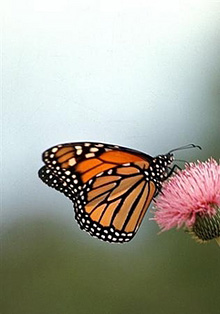 |
 |
 |
 Editorials | Environmental | July 2007 Editorials | Environmental | July 2007  
Border Fence Seen Harming Ocelots, Butterflies
 Ed Stoddard - Reuters Ed Stoddard - Reuters
go to original


| | A butterfly in an image courtesy of Texas Parks and Wildlife Management. Conservationists are concerned that a planned border security fence to stem illegal immigration from Mexico could cut a delicate area up even more and possibly remove the corridor of vital riverbank habitat that remains. (Reuters) |
On the Rio Grande, Texas - The riot of green vegetation that lines both sides of the Rio Grande river along the southeast Texas and Mexican border can give a canoeist the impression of gliding past unbroken wilderness.

But the strip of riparian forest that runs a few miles between the Texas towns of Fronton and Roma is deceptive.

In reality one of the most ecologically diverse corners of the United States has been diced up by farming and urban sprawl into isolated fragments of habitat that support far less wildlife than when they were whole.

Now, conservationists are concerned that a planned border security fence to stem illegal immigration from Mexico could cut this delicate area up even more and possibly remove the corridor of vital riverbank habitat that remains.

"We know as habitats become fragments whether by roads, fences or walls animals become much less capable of roaming widely," said Dr. Joel Berger, a senior scientist with the New York-based Wildlife Conservation Society.

"As these restrictions occur animals become isolated and with isolation the risks of local extinctions greatly increase," he said.

Animals at risk of local extinction include the U.S. population of the ocelot, a wild cat that is down to a few dozen animals, and several species of birds. Rare native plants such as sabal palm trees are down to a few isolated patches.

Driving along Route 281 which hugs this section of the Rio Grande reveals what lies behind the forested facade on the river's edge -- fast-growing border towns and cultivated fields of corn, sugar cane and other crops.

At stake is the sheer diversity of life in a region of lush subtropical vegetation threaded by a great river, lying between vast arid landscapes to the west and the Gulf of Mexico to the east.

Few Americans are aware of the area's ecological significance, which in four counties includes 300 butterfly species -- more than the rest of the country east of the Mississippi -- and over 500 different birds.

RECONNECT THE DOTS

Ecologists are trying to reconnect the dots by revegetating old farmland with native plants which they hope to link up.

At the Nature Conservancy of Texas' 1,000-acre Southmost Preserve, the contrast is plain along a dirt road with a cornfield on one side and wild bush on the other.

"This side looked exactly like that cornfield seven years ago," said Lisa Williams, a local project director with the Nature Conservancy, as she pointed to the tangle of wild growth which included haunting tepegauje trees -- a key species of the area -- their feathery leaves blowing in the wind.

"These are the pearls in a necklace which we are trying to string together," she said.

A pair of coyotes ran furtively through a field while a coot, an aquatic bird, chattered from a wetland.

When ecologists look at a patchwork of ecosystems cut up by roads or farms they think of islands -- and like islands out to sea, their isolation can be the undoing of their inhabitants.

According to the World Conservation Union, about 800 species have become extinct since 1500, when records began. Most were on islands.

But scientists say that extinctions and steep local population declines are now creeping onshore because continental habitats are being diced up by human activities.

Isolation makes populations more prone to sudden die-offs from disease or drought and also limits their genetic pool.

Other tracts of land besides Southmost are being protected in the area and reverted to their original state -- but there are worries the wall could cut through some of this work.

"There are two dozen species of very specialized birds that only live in the river forest and if that was cleared for the wall they will be lost to the area," said Martin Hagne, the executive director of the Valley Nature Center.

Supporters of the wall say it is needed to stem the tide of illegal immigration into the United States and the government says one green spin off will be a reduction in the mountains of litter which illicit crossers leave behind.

"I think it's well documented the affect that illegal border crossing activity has on the environment. The result in many cases is refuse left behind such as plastic bottles, clothes and discarded rubber rafts," said Michael Friel, a spokesperson for U.S. Customs and Border Protection.

He also said that in areas where effective control of the border has been reasserted such as near San Diego, local wild habitat which was trampled by illegal crossers has re-grown.

Elsewhere international fences are being dropped for conservation reasons. The fence between South Africa's famed Kruger National Park and Mozambique is being removed to make more room for elephants and other wildlife. | 
 | |
 |



